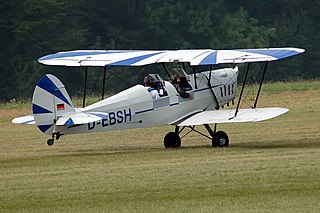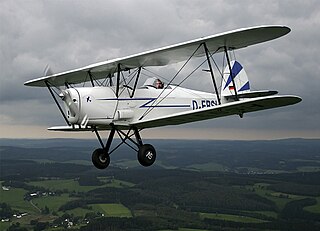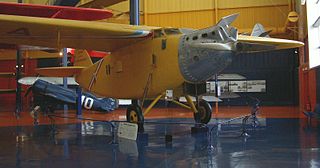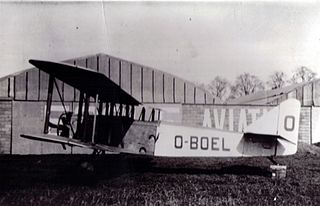Operators

- Belgian Air Force — 20 × RSV.22/180 [6]
| RSV.22 | |
|---|---|
| Role | training biplane |
| National origin | Belgium |
| Manufacturer | Stampe et Vertongen |
| Designer | Alfred Renard |
| First flight | 1926 [1] |
| Primary user | Belgian Air Force [2] |
The Stampe et Vertongen RSV.22 [3] was a training biplane produced in Belgium in the 1920s. [4] [5]
The RSV.22 was a conventional, single-bay biplane with staggered wings of unequal span that were braced with N-struts near their tips. [6] The fixed undercarriage consisted of two mainwheels that were joined by a common through axle, plus a tailskid. [6] The student pilot and the instructor sat in open cockpits in tandem [4] [6] that were fitted with dual controls. [2] Construction was of mixed materials, with metal used for the undercarriage, engine mount, and cabane struts. [6] The control surfaces were operated by a rigid linkage made of dural tube. [6] The horizontal stabilizer was adjustable in flight, using a lever in the cockpit to adjust the aircraft's trim. [6] Incorrect use of this latter feature led to a number of accidents. [6] The base model RSV 22/180 was powered by a 134-kW (180-hp) Hispano-Suiza engine, but the aircraft was designed to use powerplants of up to 220 kW (300 hp). [6] The RSV 22/200 variant used a 150-kW (200-hp) Renard-built radial engine in place of the Hispano-Suiza. [6] [5]
The Belgian Air Force purchased 20 examples of the RSV 22/180. [6] In 1928, Lt Edmond Thieffry and SLt Philippe Quersin piloted a civil-registered RSV 22/180 (registration O-BAJE) on an attempt at a long-distance flight to Africa. [6] They departed Deurne on 26 June, attempting to reach Kinshasa. [6] Bad weather forced them to land at Mourmelon, France, only 230 km (140 mi) away. Resuming their journey, they were forced down a second time, this time in a marsh at Clapier, near Vauvert, still in France. [6] They abandoned the attempt at this point and successfully returned to Belgium. [6]
Data fromLes avions Renard and Jane's all the World's Aircraft 1928. [6] [7]
General characteristics
Performance
Related lists

The Amiot 143M was a late 1930s French medium bomber designed to meet 1928 specifications for a bomber capable of day/night bombing, long-range reconnaissance and bomber escort.

The MB.210 and MB.211 were the successors of the French Bloch MB.200 bomber built by Societé des Avions Marcel Bloch in the 1930s and differed primarily in being low wing monoplanes rather than high wing monoplanes.

The Caudron C.59 was a French, two-seat biplane with a single engine and a canvas-covered fuselage, produced between 1922 and 1924. Suitable for a variety of roles, more than 1,800 Caudron C.59s were manufactured.

Morane-Saulnier MoS-50 was a French parasol configuration trainer aircraft built in 1924. The twin-seat aircraft was of wooden construction and was one of the last aircraft to have a rotary engine, a 97 kW (130 hp) Clerget 9B.

Potez 25 was a French twin-seat, single-engine biplane designed during the 1920s. A multi-purpose fighter-bomber, it was designed as a line aircraft and used in a variety of roles, including fighter and escort missions, tactical bombing and reconnaissance missions. In the late 1920s and early 1930s, Potez 25 was the standard multi-purpose aircraft of over 20 air forces, including French, Polish and American. It was also popular among private operators, notably mail transport companies.

Stampe et Vertongen was a Belgian aircraft manufacturer formed in 1922 and based at Antwerp. The company specialised in design and construction of primary trainers/tourers and advanced trainers. One of their products - the Stampe-Vertongen SV.4 - has become known in certain countries as just Stampe.

The Stampe et Vertongen SV.4 is a Belgian two-seat trainer/tourer biplane designed and built by Stampe et Vertongen. The aircraft was also built under licence in France and French Algeria.

The Bernard 190 or Bernard-Hubert 190 was a French airliner of 1928. It was a high-wing cantilever monoplane of conventional configuration, based on the Bernard 18. Compared with its predecessor, it kept the same basic design but featured redesigned tail surfaces, an enlarged cabin, and offered its flight crew a completely enclosed cockpit. Also like its predecessor, the basic airliner model provided the basis for a long-range aircraft to be used in record attempts, the 191GR.

The Farman F.120 and its derivatives were a family of multi-engine airliners and bombers of the 1920s built by the Farman Aviation Works in France.
The Renard Epervier was a Belgian prototype single-seat all-metal fighter monoplane designed by Alfred Renard at the Societé Anonyme Avions et Moteurs Renard for a government-sponsored design contest in 1928. The Epervier Type 2 was built and flown in 1928, by Belgian aircraft manufacturer Stampe et Vertongen. It carried an armament of two synchronised 7.7mm guns and was lost in September 1928 after failing to recover from a flat spin. A second prototype, the Epervier Type 2bis, introduced revised streamlined fairings for the cantilever mainwheel legs, mainwheel spats and cylinder aft-fairings and was built by SABCA.

The Renard R.35 was a prototype pressurised airliner of the 1930s built by the Belgian aircraft manufacturer Constructions Aéronautiques G. Renard. A three-engined low-winged monoplane with retractable undercarriage, the R.35 was destroyed in a crash on its first flight.
Alfred Renard was a Belgian aviation pioneer.

The Stampe et Vertongen RSV.26/140, RSV.26/180, and RSV.26 Lynx were a family of training biplanes designed by Alfred Renard and built by Stampe et Vertongen in Belgium in the 1920s. They were produced as a response to a requirement by the Belgian Air Force, which became their biggest user, although private owners also bought a small number.

The Stampe et Vertongen RSV.26/100, RSV.18/100, RSV.26/18, and SV.18 were a family of two-seat touring aircraft designed by Alfred Renard and built by Stampe et Vertongen in Belgium in the 1920s and under license by Gates Aircraft in the United States as the Gates Convertiplane. Originally designed as a biplane, a monoplane version soon followed, and the aircraft was eventually marketed as convertible between the two configurations. Sometimes described as a lightened version of the RSV.26/140 military trainer, the RSV.26/100 was actually a fresh design.

The Blériot 111 was a French four-seat executive transport monoplane designed by André Herbemont. The first French aircraft to be fitted with a retractable landing gear, after six years development it was not ordered into production.
The Stampe et Vertongen RSV.28/180 Type III, also known as the RSV.28-PSV was a military trainer aircraft built in Belgium to teach instrument-flying techniques. It was a response to a 1929 order from the Belgian Air Force, whose instrument-flying certification required a flight around a 100-kilometre (62 mi) triangular course and return to a point less than 5 kilometres (3.1 mi) from the start, using instruments only.

The Stampe et Vertongen RSV.32 was a trainer aircraft produced in Belgium in the early 1920s. Designed originally for the Stampe et Vertongen flying school, the Belgian Air Force became a major operator of the type, where it became the first aircraft of entirely Belgian design and manufacture to enter service. Many others were purchased by flying clubs and private owners. No RSV.32 was in existence by the end of World War II.

The Stampe et Vertongen SV.5 Tornado was a military trainer aircraft designed and built in Belgium in the 1930s. It saw service with the Belgian Air Force and Latvian Air Force, and Latvian firm VEF purchased a production license, although it is uncertain whether it built any examples.
The Adolphe Bernard AB was a family twin-engined French biplane aircraft, built near the end of the First World War. Ten AB 1 BN2 bombers were produced for the Armée de l'Air but did not reach squadron service; post-war, two civil derivatives were considered but only one aircraft was built.

The Caudron C.101 and its variants, the C.103, C.104 and C.107 were French two seat reconnaissance aircraft flown from 1925, differing in their engines.